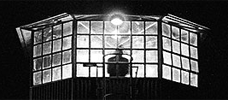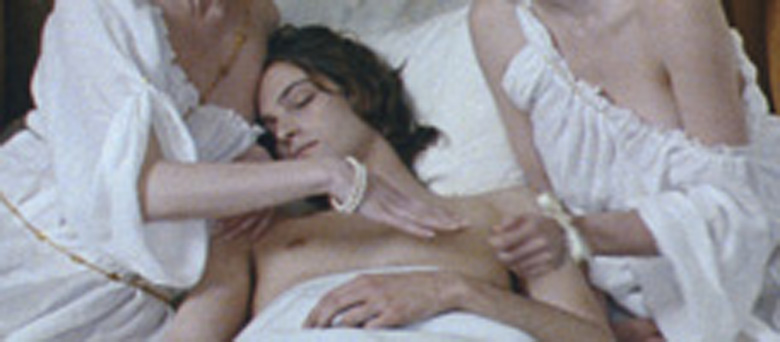Reviews
Les Amours d’Astrée et de Céladon
Eric Rohmer
France, 2007
Credits
Review by Leo Goldsmith
Posted on 03 October 2007
Source Review source: Rézo Films 35mm print
Categories The 45th New York Film Festival
The Romance of Astrea and Celadon is based on portions of the 17th century novelist Honoré d’Urfé’s L’Astrée (which the late Henri-Jean Martin called “the first bestseller” of French narrative fiction), and as such it is one of only a handful of Eric Rohmer’s fifty-odd films to be set in a historical time-period. This fact is worth emphasizing, not only because Astrea and Celadon is the work of a director inextricably linked with the intricacies of modern love, but also because it is, like Rohmer’s other such films, a distinctly odd period piece.
At first glance, Astrea and Celadon seems a fairly straightforward, somewhat stagey, and distinctly corny literary adaptation. Romping through charming bucolic scenes, the impossibly nubile young characters — a shepherd and shepherdess — navigate the travails of romance in a familiar mode of pastoral comedy. The two lovers, whose union is opposed by their warring families, agree that Celadon should pretend to be in love with another shepherdess for the sake of his family. But when Astrea spies Celadon with this other shepherdess, she believes that he has actually fallen in love with her, and thereafter Astrea tells Celadon to leave her sight forever, “unless I bid you otherwise.” This dictum prompts Celadon to declare, “I’ll drown myself at once,” but he fails in his attempt, drifting downriver quite literally into the bosom of three nymphs of the forest. Thinking her beloved dead by her own cruel treatment, Astrea drifts into despair, vowing never to love another, while her Celadon strives to escape the lusty clutches of the wood-nymphs. But even when he finally does so, he holds to his romantic ideals. He continues to obey his lover’s proclamation to leave her sight until told to do otherwise, and much of the rest of the film comprises a series of discourses on the nature of love, duty, and fidelity, while other characters (and, unseen, Fate itself) conspire to reunite the two lovers, with much cross-dressing and erotological debate.
The films in Rohmer’s career that this film most resembles (at least superficially) are the two literary adaptations he made immediately following his Six Moral Tales: Perceval le Galloise and Die Marquise von O. The former of these, Perceval is widely renowned as the director’s first flop. Seemingly a work of “filmed theater,” shot entirely on very artificial stages (like the false landscapes of his later period film, The Lady and the Duke), the film is a stark contrast to his prior works of hyperrealistic contemporary life. But this contrast would seem to be very much Rohmer’s interest, as it is in the present film. Pointedly, Rohmer situates Astrea and Celadon in real meadows and forests, but his actors, dressed in the garb of 17th century shepherds, stick out theatrically nonetheless (importantly, the acting in the film also seems more theatrical than cinematic). But again, this strange mixture of realistic and artificial elements — along with the strange mixture of digital video and 17th century pastoralia — is essential to the film and, if little else, part of its strange charm. If it does not exactly provide the viewer with a slice of 17th century shepherd life, it nonetheless marks a gap, an appreciable distance between text and image, between 17th century French literature and 21st century French cinema, and indexes the vast differences in the conventions, morés, and styles of each.
As the film’s epigraph promises to portray the characters as they would have seemed to their original, 17th century audience, Rohmer maintains a featherweight, almost naïve tone throughout. The actors are quite ingenuous in their roles, even as the film expounds upon virtues and absolutes of love that seem almost simplistic compared to the romantic conundrums of his Six Moral Tales. The seeming innocence that the film projects is amusing, if initially somewhat cloying, but it’s perfectly aligned with the edifying bel esprit ideals that art and literature were obliged to elucidate at the time of the novel’s writing. Even so, the discursive structure is very much in keeping with Rohmer’s earlier work, albeit largely stripped of the messiness and complication of the modern world. But even this distinction provides a fruitful juxtaposition, and even if The Romance of Astrea and Celadon seems quaint in its idealistic rusticity and charming in its disquisitions on the proper conduct of love, it never feels hermetic or stuffy. The contrast of stylized performances and verdant nature emblematize an openness, an expansiveness that permeates the text itself, not only to hint at the romantic complexities of Rohmer’s other films, but also to mark the changing aesthetic conceptions of love in literature (and film) over the centuries. And though its almost childlike idealism about love is surely an anomaly in contemporary cinema, the film has a good deal more in common — in its earnest tone and methodical execution — with the Rohmer of the 1960s and 70s than at first seems evident.
As the work of a director approaching ninety years of age, with characters who are as green as the landscape, the film might come off as somewhat puerile in its lavished attention to fresh-faced youths and girls with gossamer gowns that fall ever so accidentally off their pert breasts. And the characters themselves, especially the fey, dutiful Celadon, seem quite contrived and psychologically unlikely by the standards of Rohmer’s early work. But there are of course a number of concordances between this film and Rohmer’s earlier, better known work, if one seeks them out. Celadon himself, strange though his dutiful adherence to his lover’s edict seems, is another of Rohmer’s quietly tortured, indecisive men, very much the descendent (or antecedent?) of Trintignant in My Night at Maud’s or Frédéric in Love in the Afternoon. As he strolls through woods, singing or piping out a hopelessly dainty lover’s ballad, the audience’s main interest is trying to parse his motivations — is he a loyal amoureux, holding true to his lover’s word, or merely a coward?
Formally, too, Astrea and Celadon is very much a part of Rohmer’s earlier preoccupations. Text and image — and, by extension, reasoning and reality — vie throughout the director’s work, and here, as in Claire’s Knee there are constant tugs of war between what we read onscreen and what we observe enacted, between rules, poems, and dicta laid out by the characters or the narration and the complex situations that arise because (or in spite) of these. In the earlier film, Jérome is subject to the rules of engagement that Aurora sets out in letters, and the principal drama of the film is the tension between the directives and speculations offered by Aurora’s letters and what might happen or be happening to Jérome in his furtive romantic negotiations with two teenage girls. And in Astrea and Celadon, as in Claire’s Knee, Rohmer stages his action in a setting of often impossible natural grandeur — the former, the pre-moderm Druid forests of post-Roman France; the latter, Lac d’Annecy in Haute-Savoie, at the Western edge of the Alps. In each film, the sharp cuts from epic, almost unreal natural beauty to onscreen text are suggestive of a deep ravine between thought and action, logic’s grand designs and the ineluctable course of circumstance. What distinguishes Rohmer in this regard, however, is that this division — between what we desire and strategize and plan and what really happens, through nature or accident — is rarely portrayed as tragic, rather it is all part of the complexity of living. And in Astrea and Celadon, as “simple” and old-fashioned as d’Urfé’s world is made to seem, this complexity is palpable, as the characters’ ideals of romance are tried and tested by accident, misunderstanding, and encounters with differing romantic ideals (like those of the bawdy minstrel who wanders in and out of the film).
This contrast between the expansive sensual world and the grammar that our logic applies to it is once again what fascinates Rohmer, and despite the film’s favorable outcome, it remains unclear exactly where Rohmer stands: whether he fully agrees with Celadon’s to-the-letter notions of duty and obedience to love’s laws or thinks them foolish. Whatever the case, it’s apparent that Rohmer is once again drawn to the orderliness of the logic and interpretation that his characters give to love, and here he is evidently deeply satisfied by the justice of the conclusion that results. And in this respect, as this is reportedly Rohmer’s last film, this resolution is the film’s most surprising (and for Rohmer, innovative) element: a quite decisively and unreservedly happy ending. It is both tidy and witty in a manner reminiscent of Shakespeare’s comedies, and in comparison to the searching, equivocal, ever-questioning endings of Rohmer’s other films, it has a sense of finality that seems unusual. It is, for Astrea and Celadon, a new beginning, attended by all of the hope and searching and uncertainty of love that we expect from Rohmer, but as the ending of a film and a career, it is final all the same.
More The 45th New York Film Festival
-

The Darjeeling Limited
2007 -

Hamlet
1921 -

The Romance of Astrea and Celadon
2007 -

Secret Sunshine
2007 -

Paranoid Park
2007 -

Alexandra
2007 -

Before the Devil Knows You’re Dead
2007 -

The Diving Bell and the Butterfly
2007 -

The Last Mistress
2007 -

The Man from London
2007 -

I’m Not There
2007
We don’t do comments anymore, but you may contact us here or find us on Twitter or Facebook.



